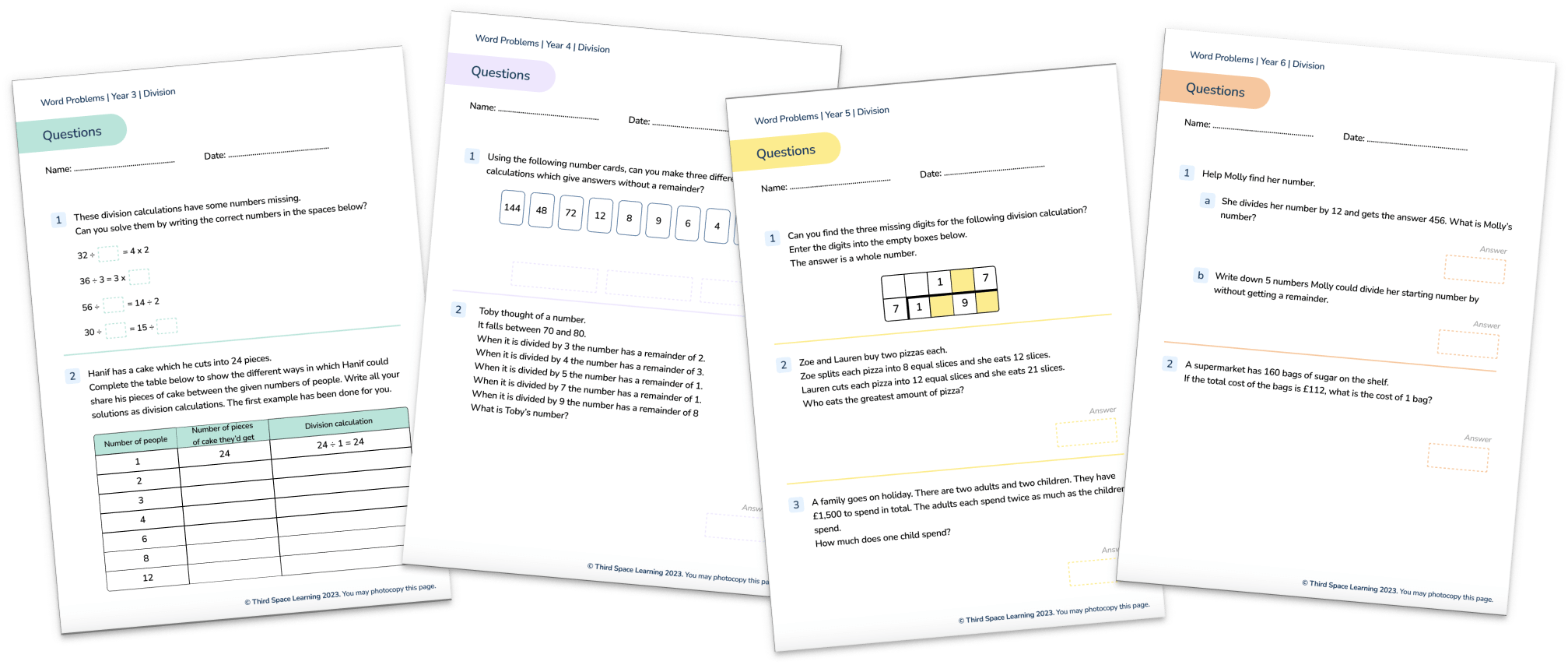25 Division Word Problems for Year 2 to Year 6 With Tips On Supporting Pupils’ Progress
Division word problems are important in building proficiency in division. Division is one of the bedrocks of mathematics alongside addition, subtraction and multiplication. Therefore, it is vital that pupils have a deep understanding of division, its function within arithmetic and word problems, and how to apply both short division and long division with success.
Division itself is the mathematical process of breaking a number up into equal parts and then finding out how many equal parts you can have. It may be that you have a remainder following this division or you may have no remainder and so a whole number as your answer.
All Kinds of Word Problems Division
Download this free pack of division word problems to develop your class' word problem solving skills
Download Free Now!- What are division word problems?
- Division word problems in the national curriculum.
- Why are word problems important for childrens’ understanding of division?
- How to teach division word problem solving in primary school.
- Example of a division word problem
- Examples of division word problems in the primary setting
- Year 2 division word problems
- Year 3 division word problems
- Year 4 division word problems
- Year 5 division word problems
- Year 6 division word problems
- More word problems resource
What are division word problems?
Division word problems are an extension of the arithmetic method whereby they are word problems with division at the heart.Pupils will be expected to use the process of division to find a solution to the word problem.
Typically, word problems use a story as a scenario and are based on a real life situation where pupils are expected to interpret what the word problem is asking and then apply their division knowledge to find the answer. Division can also be introduced early through the idea of grouping before advancing to the formal method of short division and long division.
To help you with the division journey, we have put together a collection of division word problems which can be used for children between Year 2 to Year 6 – also aimed at both 3rd grade and 4th grade pupils in America.
Division word problems in the national curriculum.
Division word problems in KS1
The national curriculum states that division and word problems should be encountered from Key Stage 1 and throughout our pupils’ primary school journey. Practical resources such as counters, dienes cubes and base ten can be used to supplement the teaching of division.
In Key Stage 1 the focus is on simple addition and subtraction word problems, however, it is standard practice to introduce the concept of grouping and sharing small quantities and to calculate the answer using concrete objects and pictorial representations. It is at this point that the idea of finding fractions of objects can also be introduced and that whilst multiplication of two numbers can be done in any order (the commutative theory), the division of one number by another cannot.
Division word problems in KS2
As children enter Lower Key Stage 2 they begin to develop their mental and written strategies for division. Pupils will begin to use their multiplication knowledge and times tables to assist in their solving of division problems and how they can use the corresponding division facts and multiplication facts to answer questions.
By the end of Year 4, pupils are expected to recall their multiplication and division facts for multiplication times tables up to 12 x 12. They should also use their knowledge of place value, and known and derived facts to assist with simple division such as dividing by 1 and halving.
Introducing short division
Short division is the next step in Lower Key Stage 2. Pupils practise their fluency of short division, also known as ‘the bus stop method’, in order to answer division word problems that have a whole number answer, and those with a remainder.
Before entering Upper Key Stage 2, pupils encounter division word problems and multi step problems with increasingly harder numbers going from a simple short division problem, such as, ‘If we have 30 pupils in our class and we are divided into groups of 5, how many pupils will be in each group?’ to ‘If there are 56 books in our library and they are shared amongst 7 children, how many books would each child get?’
Introducing long division
As our pupils enter Upper Key Stage 2, long division is introduced. By the end of KS2 pupils should be fluent in both multiplication and division and the written strategies, and be able to apply knowledge in fraction word problems and percentage word problems.
Year 5 pupils work towards being able to divide up to 4 digit numbers by a one digit number using short division and being able to interpret remainders in the correct context – even presenting the remainder as a decimal or fraction. Pupils should also be able to divide mentally and know how to divide by 10, 100 and 1000 and how place value works alongside dividing a number so it is 10, 100 or 1000 times smaller.
Year 6 pupils are expected to consolidate on the above formal methods of short division before being able to divide a four digit number by a two digit number using the formal method of long division and to again be able to understand remainders within this and present them in the correct context.
This also flows into division word problems as children should be able to read a multi step problem and know how to correctly interpret it, apply their divisional knowledge and solve the problem successfully. The concept of multi step problems is built upon at each stage of the national curriculum.
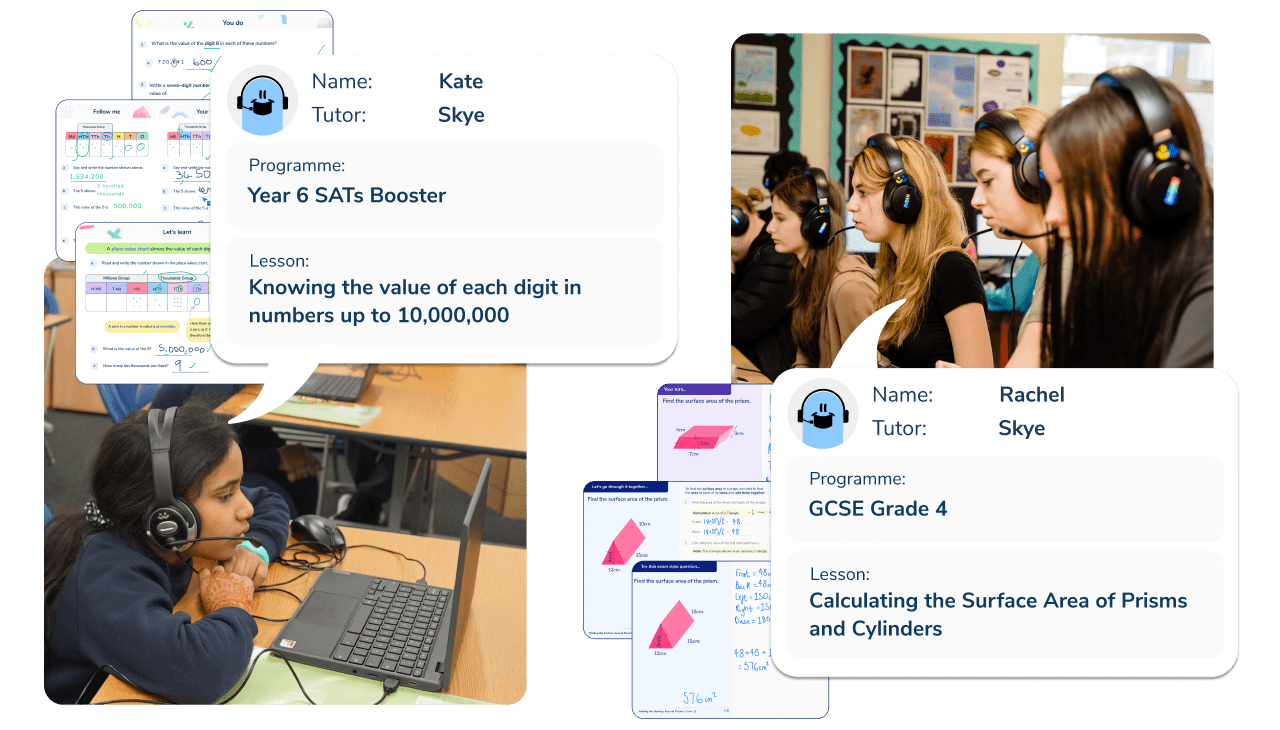
Meet Skye, the voice-based AI tutor making maths success possible for every student.
Built by teachers and maths experts, Skye uses the same pedagogy, curriculum and lesson structure as our traditional tutoring.
But, with more flexibility and a lower cost, schools can scale online maths tutoring to support every student who needs it.
Watch Skye in actionWhy are word problems important for childrens’ understanding of division?
Word problems, alongside the use of concrete objects and pictorial representations, are important in helping children understand the complexities and possible abstract nature of division.
Whilst children may understand that when we divide our answer will be smaller, before providing a child with word problem worksheets, just like with exploring arrays to support multiplication word problems, it is important to visually explore how division looks – from grouping and beyond.
Applying maths to real life situations
Word problems are important because they provide a real life context for children to understand division and how we encounter it in real life. By allowing children to see how division is used in everyday situations, children will find it more meaningful and relevant which in turn develops a deeper understanding of the four operations as a whole.
Building problem solving skills
Word problems are also vital to developing problem solving skills. Firstly, they must read and understand the problem before being able to identify the relevant information within the contextual problem and apply their knowledge to find a solution. This naturally builds critical thinking and a child’s ability to reason, which is an important skill for any mathematician.
Developing mathematical language skills
Finally, the importance of moving from simple division word problems to more challenging ones enhances pupils’ vocabulary and language skills. For children to develop an understanding of vocabulary such as divisors, quotient and remainders means they must first understand these key words and apply it to the process of division and be able to communicate clearly what they are aiming to do.
Deepening understanding of the inverse relationship between division and multiplication
Division word problems also solidify the connection between multiplication and division. Understanding these inverse operations and being able to interchange the skills of multiplication and division will help make connections between different mathematical concepts and deepen pupils’ learning.
How to teach division word problem solving in primary school.
Having taught the concept of division to pupils using concrete examples, for example how to group or share counters and cubes, the next step is to advance to division word problems.
As with all word problems, it is important that pupils are able to read the question carefully and interpret it so they know what they are being asked. Do they need to add, subtract, multiply or divide? Do they need to solve a multi step problem and so need to do more than one step? They may decide what operation to do, in this blogs’ case – division, and then choose to represent it pictorially.
Example of a division word problem
There are 40 sweets ready to go in the party bags for Laura’s birthday. They are to be shared between 8 friends. How many sweets will each child get?
How to solve this:
Firstly we need to interpret the question. Laura has invited 8 friends to her party and she has 40 sweets to share equally between her friends. So we know:
- There are 40 sweets in total
- They are to be divided amongst 8 friends in total
- We therefore need to divide the total number of sweets (40) by the number of friends (8). So to solve this problem we could put the total number of sweets (the dividend – 40 ) in the ‘bus stop’ for short division and divide by the total number of friends (the divisor – 8). If we do this, we would get the answer of 5 – the quotient. Each friend would get 5 sweets each as 40 divided by 8 is 5.
- Alternatively, we could use the inverse – multiplication – to solve this problem. We may not know the division fact that 40 divided by 8 = 5 but if we look to the inverse we may know what numeral multiplied by 8 equals 40. If we did our 8 times table we would get the answer of 5 – the correct answer.
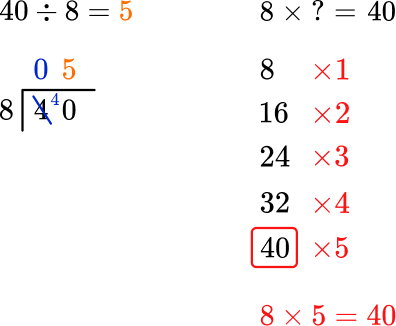
How can we show this pictorially?
We could show 8 circles – each circle to represent a child – and place a sweet in each circle until we have placed all 40 sweets. This would mean we have shared the sweets equally between the friends and would result in each child having 5 sweets.
We could represent the division word problem as a bar model. We could split the bar model into 8 sections. There are 40 sweets and so we share them between the 8 sections. We will again see each section gets 5 sweets.
The below visuals show how this would look:
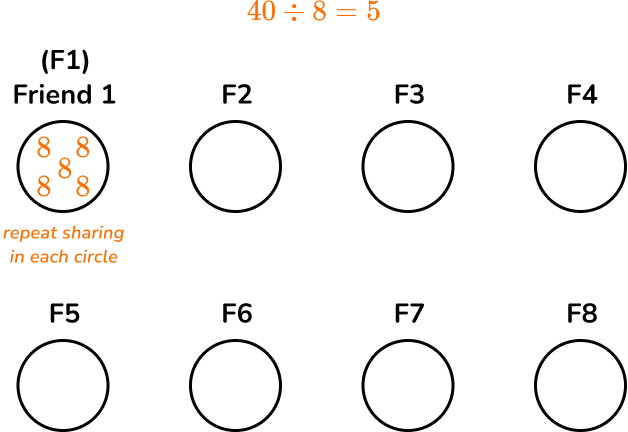
Or:
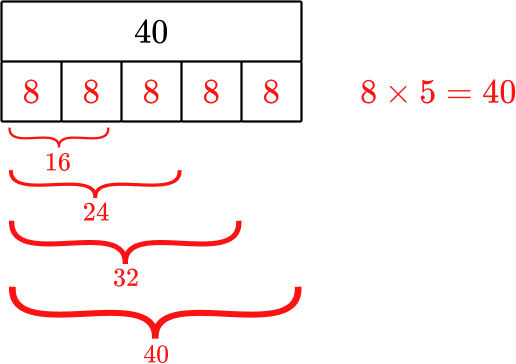
Word problems are an important aspect of learning in Third Space Learning’s AI maths tutoring with Skye, the AI maths tutor. Skye works with pupils to break down word problems and identify the correct operation needed to solve them.
Examples of division word problems in the primary setting
Below are examples of what can be expected at each year group from Years 2 to 6. Through our AI tutoring programme with Skye, pupils will become familiar with word problems throughout their learning. They will encounter word problems on a regular basis with each lesson personalised to develop the learning our pupils need. The word problems will increase their confidence, their familiarity with vocabulary and their mathematical understanding.
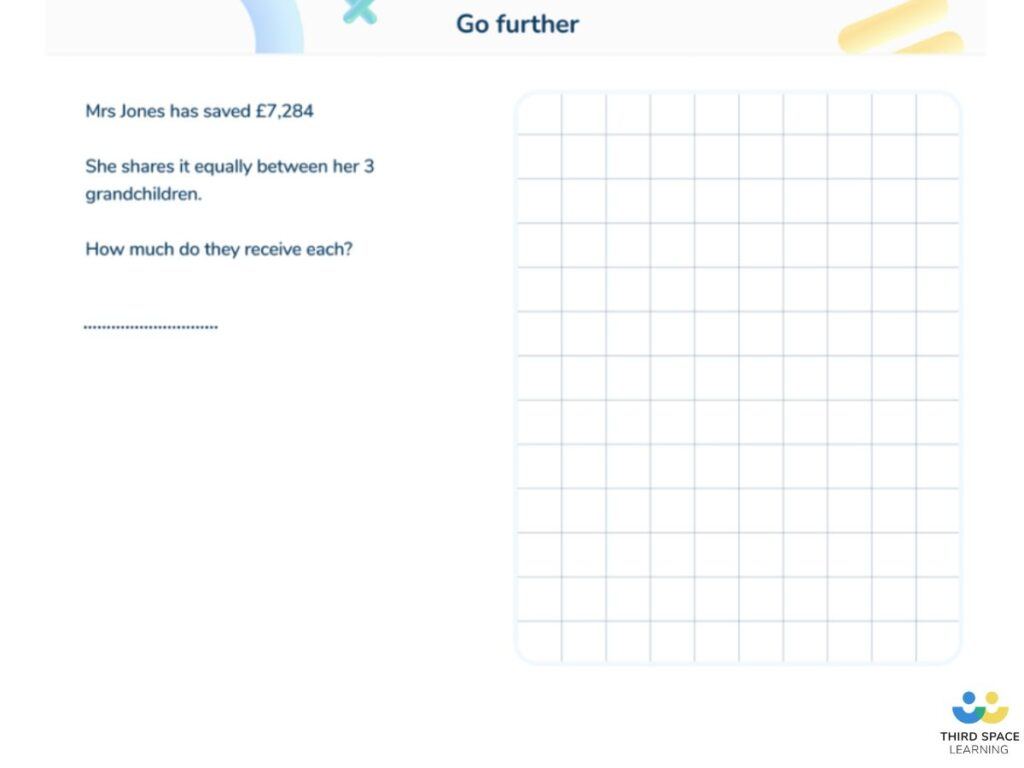
Division word problems are essential to developing problem solving skills and mathematical reasoning.
Year 2 division word problems
In Year 2 pupils use division facts for the 2, 5 and 120 times table and solve problems using concrete materials, arrays and see word problems in context.
Question 1:
Rosie picks 12 apples on a summer walk and wants to share them equally into 4 baskets. How many apples will be in each basket?
Answer: 3
12 divided by 4 = 3
Pictorially this would look like:
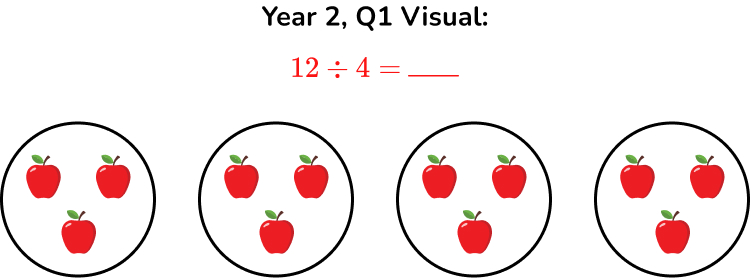
Question 2:
Amy loves baking and has baked 20 cup cakes. She wants to divide them between ten friends. How many cupcakes does each friend get?
Answer: 2
20 divided by 10 = 2
Question 3:
If I have a pizza and it is cut into 16 slices, and I share it amongst 4 people. How many slices will each person get?
Answer: 4
16 divided by 4 = 4
A multiplication fact that would help with this question would be to know 4 x 4 = 16
Question 4:
Rhys says, ‘I have 36 football trading cards and I am going to share them between my 2 friends. Each of my friends will get 14 cards.’ Is Rhys correct?
Answer: he is incorrect
Rhys is incorrect. If he correctly shares 36 cards between his 2 friends, each friend will get 18 cards because 36 divided by 2 = 18.
Question 5:
If a picnic bench can fit 8 children on it, and there are 24 children in our class, how many picnic benches will we need for our class to all have a seat?
Answer: We will need 3 benches.
24 divided by 3 = 8
Year 3 division word problems
With word problems for Year 3, pupils should begin using their recall of the 3, 4 and 8 times table to help with division word problems and be able to divide two digit numbers by one digit numbers using mental and short division.
Question 1:
if a school has 90 pupils in Year 3 and there are 3 classes in Year 3, how many pupils are in each class?
Answer: 30
90 shared equally into 3 classes = 30 children per class
Question 2:
Every day a school gets a delivery of milk in a crate. There are 96 cartons of milk in the crate. If there are 8 milk cartons in a pack, how many packs will be in the crate?
Answer: 8
96 divided by 12 = 8.
There are 8 cartons of milk in a pack.
Question 3:
A delivery of 124 footballs arrives at school for sports day. They are to be shared equally between 4 classes. How many footballs does each class get?
Answer: 31
124 divided by 4 = 31 footballs per class
Question 4:
Year 3 is going to the beach on a school trip. If there are 150 children in Year 3 and only 10 children can go on one mini bus, how many mini buses does Mr. Pearson need to book?
Answer: 15
150 children divided 10 = 15 mini buses.
Question 5:
Everly has a bag of 66 marbles. She says ‘If I share these marbles equally between 8 people, I will have 2 left over.’ Is Everly correct?
Answer: Yes, Everly is correct.
If we divide 66 into 8 groups we will have 2 marbles left.
This is because 66 divided 8 is 8 equal groups with 2 left over, because 8 x 8 is 64 and so there will be 2 marbles left.
Year 4 division word problems
With word problems for year 4, pupils should be using their full knowledge and recall of times tables to 12 x 12 to help with short division of 2 digit and 3 digit numbers by a 1 digit number. Word problems may also involve multi step problems. Remainders may also be within the answer.
Question 1:
If you have 61 flowers and divide them into four flower pots, how many flowers are in each pot? Are there any left over?
Answer: 15 flowers in each pot with 1 flower left over
If we divide 61 into 4 equal groups then we can use the short division method.
We put 61 into the ‘bus stop’ and divide it by 4.
We ask ourselves, how many 4’s go into the first number ‘6’ – and we know 4 x 1 = 4, so only one 4 goes into 6 but we have 2 remaining. We put that 2 next to the 1 in 61 and we now have the number ‘21’. How many 4’s go into 21? 4 x 5 is 20. Therefore, 5 lots of 4 go into 20. We now have the answer 15 flowers….but we would have 1 left over as we had to divide 21 by 4.
So the answer to 61 divided by 4 = 15 remainder 1.
This would look like:
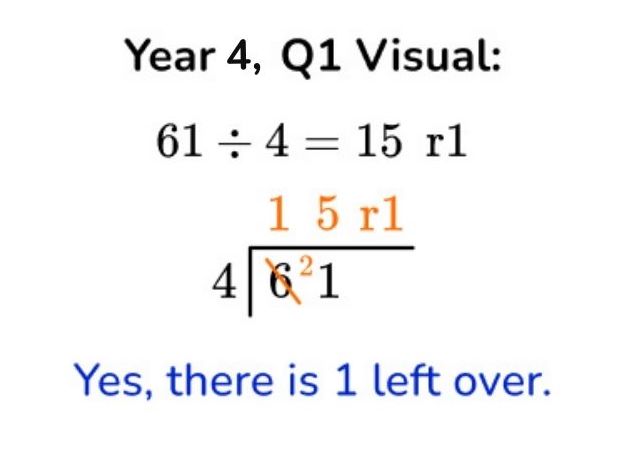
Question 2:
A plate can hold 9 cereal bars. There are 180 cereal bars to put out. How many plates do we need?
Answer: 20 with no remainder.
180 divided by 9 = 20 with no remainder.
We may also know that 9 x 2 = 18 and so can use our place value knowledge to know that 9 x 20 = 180 as the answer would be ten times bigger than 9 x 2.
Questions 3:
Amy is calculating 188 divided by 11 and thinks that as the number 188 ends in an 88, that there will be no remainder. Is she correct?
Answer: Amy is incorrect.
If we do 188 divided by 11 we will get 17 remainder 1.
Question 4:
There are 216 animals in a zoo and they are spread out across 8 different zones. How many animals are in each zone?
Answer: 27
216 divided by 8 = 27
Question 5:
At a sports tournament there are 6 players in each team. There are 132 players altogether.
How many teams are there?
Answer: 22
132 divided by 6 = 22
Year 5 division word problems
Word problems for Year 5 centre around dividing a 4 digit number by a 1 digit number using the formal method of short division. They will also interpret remainders correctly depending on the context. Division and remainders is often demonstrated through money word problems.
Question 1:
Ronan has a ball of string that is 819cm long. He cuts it into 7 equal pieces. How long is 1 piece of string?
Answer: 117cm
819 divided by 7 = 117
Question 2:
In Key Stage 2 there are 1,248 coloured pencils. If there are 6 classes in Key Stage 2, how many pencils would each class receive?
Answer: 208cm
We use the short division method to divide 1,248 by 6 and we get 208 as the result.
Question 3:
Mia buys three computer games for £84.99. How much is one computer game?
Answer: £28.33
Whilst this involves decimal division due to it being monetary with pounds and pence, the process of short division is the same.
We divide £84.99 by 3 and we get £28.33.
Question 4:
The area of the school hall is 1,704m and needs to be split into four quadrants. What would be the area of each quadrant?
Answer: 426m
We take the total area of the school and divide it by 4 to represent each quadrant. In doing so, we would have 426m for each quadrant.
To check this is the correct answer, we could do the inverse and multiply 426 by 4 and we would get 1,704m.
Question 5:
Packets of sweets are put into multi packs of 8. The multi packs are then placed into boxes of 6. Today, 7800 packets of sweets were packed. How many boxes of sweets were packed?
Answer: 163 boxes
This is a two step problem. First we need to multiply the number of packets in a multi pack – 8 – by the number of boxes of multi packs – 6. We would get the answer 48.
We then have to take the total packets of sweets – 7800 – and divide this by 48. This would be our introduction to long division. If we do this we will get the answer 162.5.
Now we cannot have 162 and a half boxes and so we would round this up to 163 boxes – but the 163rd box would only be half full.
Year 6 division word problems
Word problems for year 6 will be preparing for their SATs exams in May. They would be familiar with the concept of long division and needing to divide a 4 digit number by a 2 digit number using the formal methods of both short and long division.
Question 1:
A school is selling tickets at £6 each to attend the Big Christmas Fair. Over 15 weeks it has earned an amazing £9,720! On average, how many tickets were sold each week?
Answer: 108 tickets per week
First, we need to use the formal method of long division to divide the grand total – £9720 by 15. If we do this correctly we will have the answer 648.
Then, we need to take this answer of 648, which is how much is earned each week, and then divide this by £6, the amount each ticket is.
This will result in the number of tickets sold each week – 108 tickets.
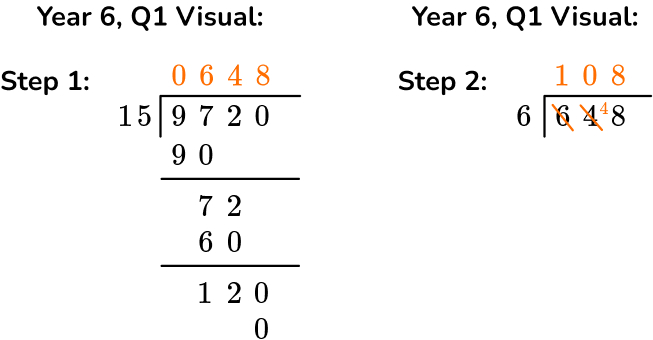
Question 2:
A square sports field has a perimeter of 2.696km. How long is each side of the field?
Answer: 674m
To answer this we need to be able to convert the 2.696km into metres. There are 1000 metres in a kilometre so that would be 2,696m. Then we divide this by 4 and get 674m for one side.
Question 3:
Keira is given a toy blocks kit containing 2,208 individual blocks. She wants to split the toy blocks evenly between 15 friends and herself to work on making a toy block city together. How many blocks should she give each of her friends?
Answer: 138 blocks
We need to use the formal method of long division to solve this. We also need to ensure we include Keira and her 15 friends so we have the number 16 as the divisor.
When we divide 2,208 by 16 using long division we get the answer 138.
Question 4:
Wesleigh was running in the cross country race. He ran for a distance of 3,569m and it took him 11 minutes to complete the race. How many metres did he run per minute? Give your answer to the nearest whole metre.
Answer: 324 metres
We need to use long division to divide 3,569 by 11. That will give us an answer of 324.45. As the decimal can be rounded down, the answer is 324 metres.
Question 5:
Sophia is preparing her sweet stall for the fair. She can fit 18 tins of sweets into one crate. How many crates will be needed to153 tins of sweets?
Answer: 9 cratesWe divide 153 by 18 using long division and we have an answer of 8 remainder 5. Therefore, having 8 crates would not be enough as we would have 85 tins left over and so we need a further tin to house the 5 tins left over. So, 9 crates are needed.
More word problems resource
Are you looking for more word problems resources? Take a look at our library of word problems practice questions including: time word problems, ratio word problems, addition word problems and subtraction word problems.
DO YOU HAVE STUDENTS WHO NEED MORE SUPPORT IN MATHS?
Skye – our AI maths tutor built by teachers – gives students personalised one-to-one lessons that address learning gaps and build confidence.
Since 2013 we’ve taught over 2 million hours of maths lessons to more than 170,000 students to help them become fluent, able mathematicians.
Explore our AI maths tutoring or find out about a primary school maths tutor for your school.



